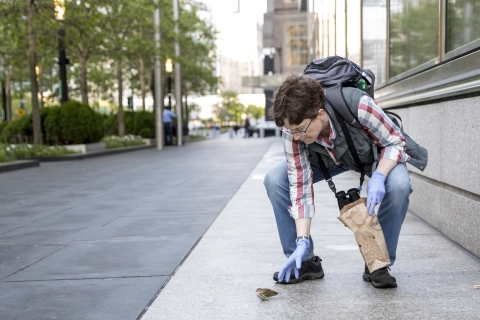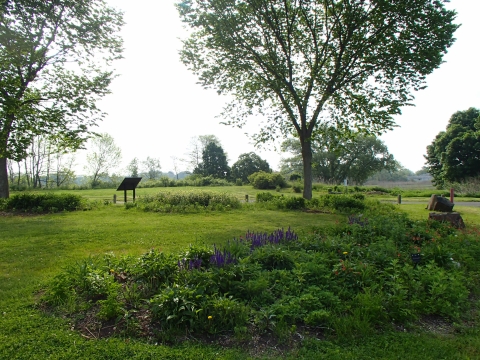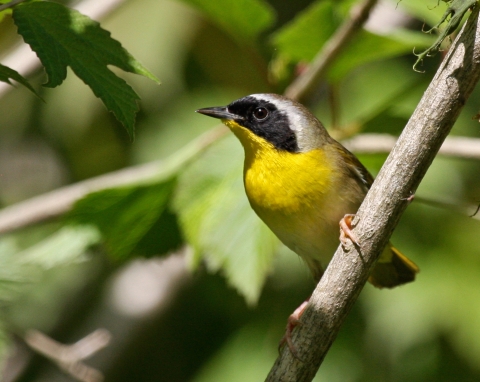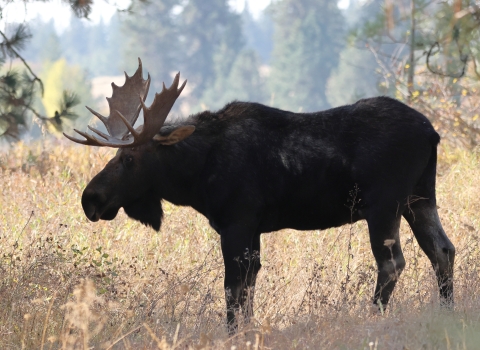On a full-moon night in the spring or fall, grab your binoculars and head outside. Looking to the bright face of the moon, you might well see a cloud of shadowed figures streaming across: migratory birds.
Millions of birds migrate across North America on any given night during migration seasons; in fact, the majority of bird migrations take place at night. There are several reasons for this: cooler temperatures put less physical demand on birds; the darkness keeps them safer from predators; and, as all great navigators do, birds use the stars to guide them on their long journey.
Dark skies keep birds safe, but the artificial light coming from our cities and homes is threatening that safety. Birds are attracted to lighting, especially in times of bad-weather events. This light can cause confusion, disorientation, and exhaustion – directly impacting their ability to migrate and increasing their chances of colliding with buildings and structures. An estimated one billion birds are killed each year from these collisions, and with our world becoming increasingly urban, the threat is expected to only grow.
This year’s World Migratory Bird Day theme is “dim the lights for birds at night.” It calls upon people around the globe to help reduce the impacts of light pollution on birds.
This message is especially relevant here in the densely populated Northeast region, where 80% of people live in urban areas. That’s why, through the Service’s Urban Bird Treaty Program, we’ve developed a network of city partnerships to support the development of long-term, innovative solutions to these challenges that will help keep migratory birds out of harm’s way.
Urban Bird Treaty partnerships receive access to funding opportunities like the National Fish and Wildlife Foundation’s Five Star and Urban Waters Restoration Grant Program, which supports projects that restore and preserve wildlife habitat and natural resources in cities where it’s needed most.
New York, the most populated metropolitan area in America, is one of those cities.
The Tribute in Light
Every year on September 11th, the Tribute in Light Memorial paints the New York City skyline with two brilliant pillars of light – a powerful image to commemorate the victims of the terrorist attacks that occurred more than two decades ago. From dusk to dawn, the blue beams reach four miles into the night sky and can be seen from 60 miles away. They are the most powerful lights to ever project from Earth.
On these nights, NYC Audubon staff and volunteers meet on the roof of an adjacent parking garage donning binoculars, nervously anticipating their task ahead: monitoring the sky all night for birds that may become “trapped” in the light. September is a big month in the fall migration, making the Memorial a significant hazard. Evidence shows the lights can lure migrating birds from three miles away.
The sight from below is unnerving. Clusters of birds appear in the light, circling slowly and aimlessly, unable to escape the beams. If trapped too long, the birds will use up all their precious energy and collapse on the ground. Come morning, they’ll be disoriented and more vulnerable to collisions.
The team works with Memorial staff to count birds as they are pulled in. Reach a thousand, and they shut off the lights for a short period of time to allow the trapped birds to disperse. Over the course of this night, their vigilance can save thousands of birds. On a broader level, this work provides insight into the relationship between birds, artificial light, and collisions – and what can be done to lessen these impacts.
Dustin Partridge, director of conservation and science at NYC Audubon, sees this important collaboration as a way to honor those lost on 9/11, while also contributing to bird conservation.
“It’s a powerful symbol for New York,” Partridge said of the Tribute in Light, “but it’s also a great example of how we’ve been able to work with the city to make it a safer place for birds.”
Setting standards
Monitoring Tribute in Light is just one night out of a year-round dedication to urban bird conservation for NYC Audubon. They’ve been the lead Urban Bird Treaty Program partner ever since New York City was designated an Urban Bird Treaty city by the Service in 2008.
Urban Bird Treaty funding supports NYC Audubon’s Project Safe Flight – an initiative to prevent bird collisions due to artificial light, glass, and structures, and to find ways to expand and improve urban bird habitat.
Project Safe Flight relies on an innovative tool called dBird, a crowd-sourced website that allows volunteers and the general public to report fallen birds found in the city. It maps out bird collisions, pinpointing hotspots where birds are routinely found. From here, the evidence can aid in the development of realistic solutions for specific buildings, as well as inform future policy changes for the whole city.
Individual collisions are reported on a weekly basis, but occasionally mass casualty events occur, too. In Fall 2021, more than 200 dead birds were found outside four buildings in Lower Manhattan – all killed from collisions with windows after becoming disoriented by bright lights.
“It’s really hard to see because these birds have migrated so far,” Partridge said of these collision events. “They’ve made it so far in their life history and are traveling these large distances. But then they get into New York and just collide with glass.”
Although the information collected by Project Safe Flight is disheartening, its use is creating a lasting, positive impact in New York City – for birds and people alike. For example, the renovation of the Jacob K. Javits Center in Manhattan – guided by NYC Audubon efforts – marked the first time a major New York City building was retrofitted with bird-friendly glass. The renovation resulted in a drop in bird-building collisions of more than 90 percent, while simultaneously making the building more energy-efficient.
NYC Audubon’s work also informed creation of a 2019 citywide policy requiring all new major construction and building renovation in the city to use bird-friendly design and materials – a change expected to have a tremendous impact in the coming years.
Centering communities
New York City is just one of nine designated Urban Bird Treaty Program cities in the Northeast. From Pittsburgh to D.C. to Baltimore, the program works with partners on the ground to restore and improve bird habitat, reduce bird hazards, and educate and engage the community in urban bird conservation.
That last point is fundamental, according to Roxanne Bogart, the Urban Bird Treaty Program’s national coordinator.
“The crux of the program is community-centered conservation,” Bogart said. That is, not sticking to a one-size-fits-all approach. Rather, it requires deepening relationships and better understanding the needs and concerns of each city and its inhabitants.
Take the Urban Oases Program for example, based in New Haven, Connecticut – another designated Urban Bird Treaty city. Led by Audubon Connecticut, it identifies underserved communities with a high need for natural spaces. Staff then work with community partners to create “urban oases” – habitat that will support migrating birds, while also creating beautiful pockets of nature for neighborhoods to enjoy.
By carrying out projects that truly benefit people, communities will be more likely to get on board with bird conservation. “Lights out” city initiatives supported by the Urban Bird Treaty Program have adopted similar messaging – turning off unnecessary lighting at night will protect migratory birds while saving people money as well.
And then there’s the most obvious benefit: healthy, thriving, and chatty birds to enjoy in our communities each day.
A bright future
NYC Audubon’s work as an Urban Bird Treaty city has set the standard when it comes to the challenges of artificial light and migratory birds.
However, that may seem like small potatoes, given New York is a behemoth of a city made up of a million buildings and counting. Meanwhile, artificial light is increasing globally every year.
Tackling the challenges of urban glow will be a massive undertaking that requires persuading more people and businesses to turn off their lights at night and inspiring new bird-friendly policies that will dramatically shift the way our cities are built.
The never-ending trend towards urbanization can be daunting through the eyes of a bird-lover. However, the collective action taking place keeps Partridge optimistic. Much like the expansive routes migratory birds trace every year on their way across North America, the Urban Bird Treaty Program has created a network of cities leading the way in urban bird conservation – a productive space where biologists, government representatives, teachers, and partners can collaborate, share ideas, and learn from one another.
“Urban conservation issues are not unique to New York or Philadelphia or Toronto; migration happens everywhere,” Partridge said. “So being able to work with others across cities to learn from each other about what works best has really been useful for making the world a safer place for birds.”
For World Migratory Bird Day on May 14th, the U.S. Fish and Wildlife Service Migratory Bird Program is encouraging you to participate in reducing the impacts of light pollution by "Dimming the Lights for Birds at Night!" By turning off your interior and exterior building lights at night, you can significantly reduce the chance for bird collisions, while also saving energy and money.












